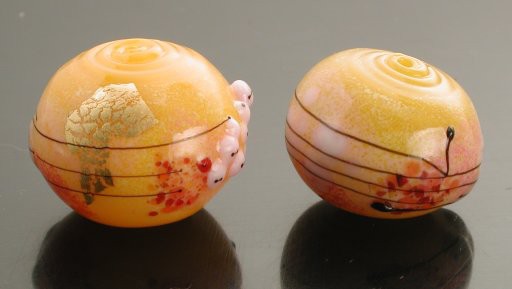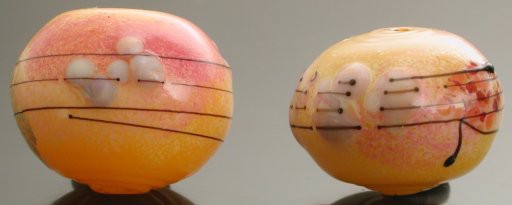I suppose this entry ought to be in the GlassTechnical area, since the point of making these beads was to compare the behavior of two glasses, Effetre's intense/dense black (066) and the new Creation is Messy's Hades (0820). But I like the way these beads came out, (and in fact, one's already sold), so they're in the regular glassbead area.
To back up: after I wrote the CiM folks (specifically, Kathy Seamands) with my concerns about compatibilty between their product and Thompson Enamels, she kindly offered to send me some free glass, if I'd like to test it. Um, is the pope Catholic? As a help, she also sent an evaluation sheet for the CiM palette for their regular testers, on the theory that it would provide some ideas for my own testing, and I did indeed find it helpful. I found the notes for Hades interesting, and was particularly struck by the following:

These beads compare Effetre 066 dense black stringer (left) with Creation is Messy 0820 Hades stringer (right).
"Hades is dense: even pulled into a stringer, it maintains dense black color."
Now of course I'm supposed to be using this free glass either to make base beads on which I apply Thompson enamel, or frit it up and put CiM frit on beads made with TE. (Or both, of course.) Well, three of the CiM colors were, I thought, perfect for a new series combining TE powders, frits and pixie dust, and I made several beads each, before getting frustrated with my lack of vase skills. I only have two rods of each color (except Gelly's sty), and I was getting tired of wasting them on unusable base beads. At the same time I felt guilty making a bunch of beads out of cheaper/more available glass to ramp my skills back up—so I settled on this compromise series of yellow abstracts made on semi-translucent effetre special 408 yellow. —Which came out of the earlier translucent CiM beads (that I still need to photograph) and, of course, as always and forever, my desire to use up something ugly, to wit, the not-completely opaque batch of 408. (So now I've found an actual use for semi-translucent opaques. Sigh.)
The only time I ever used black as a base for frit and powder beads was my 9/11 series, which I suppose someday I ought to photograph and post, since I was lucky enough to get a few of them that didn't sell back from a shop. However, I do use intense black stringer to punch up some my frit and powder beads, and of course it only takes a tiny amount of glass, thus leaving the entire 2 rods leftover for some other project. Plus, according to the literature, CiM's black is blue-based, which I happen to like in Vetrofond. So I figured, close enough—the yellow abstracts I do have trailing, so I picked out a semi-ucky yellow to use as a base (the usual version of this bead, which I have yet to post, is made on a transparent amber), and off I went.
Both the beads, chiming hollows, are made on semi-translucent 408 effetre yellow, with the following thompson enamels:
- 9260 (lemon yellow)
- 9720 (lightest pink)
- 9730 (medium pink)
- 9760 (dark pink)
- 9780 (magenta)
(laid down in that order), with three sets of artist-made frits: coarse opaque pinks, fine transparent reds and pinks (i.e. gold ruby, czech vintage garnet, and possibly 076? transparent red) and coarse creams (assorted effetre & vetrofond ivories, 255 gold opal and 266 silver pink?) on 1/16 mandrels using krag mud bead release.* Though it's on the right, the CiM bead was made first. I let it air cool, concluded the colorway was acceptable, and therefore made the second bead in this series with gold leaf. (Thus the only other differences between the beads, besides the stringer, is that one has gold leaf, and the other doesn't, and I still need to anneal the CiM bead!)
Well, they don't look much different in the picture, do they?
In fact, to the unaided eye, the dense black stringer looks significantly thinner, darker, and crisper. However, this is almost impossible to see in the photograph. —And in fact, the biggest differences are apparent as the stringer crosses the ivory/silver strike frit...which isn't shown in the first photo. (And darn, I was so proud of myself for successfully using the full manual mode exposure too.) So, right in the middle of this post, I decided to take another picture, so as to make a more convincing case:
Ok, I'm back. (Gee, that manual mode, that used to be so painful, only took a couple of minutes, and most of those was propping the beads with handi-tac to get the frit showing at the angle I wanted. Ow. I wasted years not knowing how to do this.) This pair of comparison shots more accurately captures what I'm seeing withthe naked eye. Though the hades spreads some on the pale pink pastel, its greater diffusion is most apparent on the silver strike frit, as seen here; whereas the 066 is dead consistant across everything—thompson enamels, pale opaque pink frit, ivory/silver strike frits.
To be sure, the 066 dense stringer stands slightly proud of the bead: it seems to be a somewhat stiff glass, and thus, less prone to melting in. (It should be noted that TE are extremely stiff—one reason it's so difficult to get get nicely shaped beads—which is one reason I really favor the dense black, as all the other colors are “soft” in comparison to thompson enamels, that is, they melt in readily. Hades seems to be a nicely working glass with what seemed to me average viscosity, but I'm not as sensitive to this as many beadmakers, because I've used glasses with such a wide variety of viscosities—everything from lead satake to boro.)
Now, to be fair, perhaps I should've compared it to regular blacks, but the literature did say nice and black. And it is, relatively—but not as much as the 066.
*Other technical notes: GTT lynx running on propane and a regalia 10 concentrator. AF99 combo kiln, with 980 0.5hour soak, and 600degF/hr rampdown, to 400 degF. CiM recommends a very conservative annealing schedule, but so far, this hasn't been a problem, as my beads are quite thin walled (2mm or so.) file (including all of the intro) started 18oct, add'l material 19oct07, final cleanup 20oct.
Unless otherwise noted, text, image and objects depicted therein copyright 1996--present sylvus tarn.
Sylvus Tarn